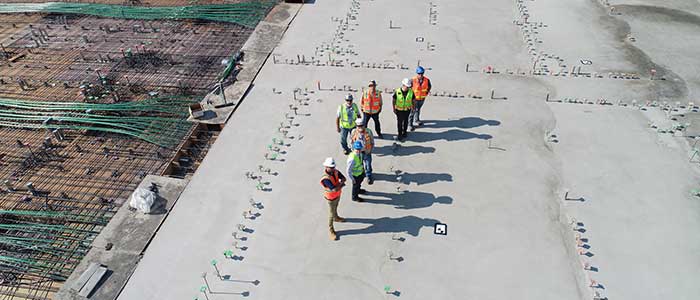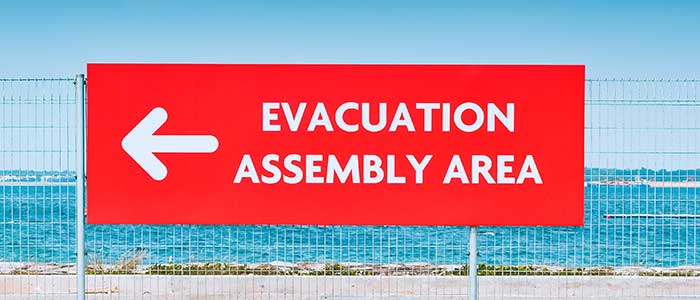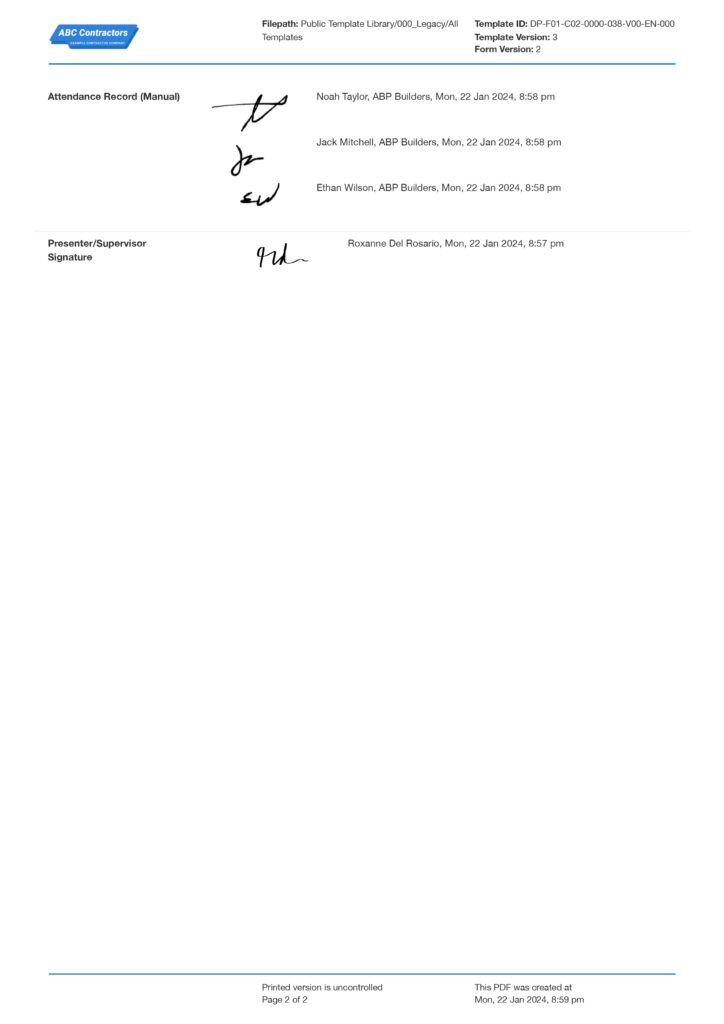Dashpivot Article – Safety Moments Ideas
Safety Moments Topics and Ideas
Short on safety moments topics and ideas? Not for long. In this article, we will provide you with a bunch of ideas as well as some free resources to execute on those ideas.

Purpose of Safety Moments
It is an undeniable fact that there are always hazards in our workplace, and it is sometimes inevitable that workers will get exposed to these hazards. But as ingenious creatures, we humans have always devised ways to mitigate and eliminate these hazards. However, these innovations that we have need a factor of consistency for them to remain effective. This is where safety moments come in.
These formal meetings are an avenue to thoroughly discuss and review the required safety steps and measures, possible hazards that may arise, and safety tips that are involved in a certain activity. The purpose of stopping, taking a step back, and reviewing all safety steps can really help implement all required safety measures and procedures in order to conduct and finish an activity safely.
Safety Moments in Construction
One of the world's oldest industries is construction. Because of its distinctive architectural styles, it has even helped to identify various civilisations worldwide. It even came to represent and serve as the foundation for our society's development. Additionally, as building techniques and processes have changed throughout time, so too have the risks involved. Additional precautions must be implemented as a result. The use of safety moments is one strategy that has proven successful. Over the years, the frequency of accidents in the construction sector has drastically decreased because of the use of safety moments.
HSE Safety Moments Topics and Ideas in Construction
Health, Safety, and Environment, also referred to as HSE, includes a variety of procedures, guidelines, and laws in order to reduce risks, stop mishaps and injuries, and encourage sustainable behaviours. This strategy is essential for sustaining sustainable operations across several industries, conserving the environment, and ensuring people's health and safety. Considering that HSE revolves around safety procedures, guidelines, and laws, it also considered providing safety moment topics that can be accessed by the construction industry. In this subsection of the article, we will be discussing the safety moments that HSE has provided.
Working at Heights
Employers and independent contractors should evaluate the danger of working at heights and then plan and arrange the job to ensure that it is done safely. HSE requires that establishments will need to attempt to avoid working at heights if at all practicable. If work at heights is required, you must otherwise establish mechanisms to avoid and halt a fall that results in harm. It is crucial to teach the staff the necessary safety measures. In the construction sector, method statements are used to assist in managing the job and convey requirements to all parties. In addition, you might check the following documents about working at heights during your safety moments, per HSE.
-
Risk Assessment
-
Safety Precautions
-
Method Statements
Structural stability
In HSE regulations (The Construction (Design and Management) Regulations 2015 on Legislation.gov.uk ), in order to prevent accidental structural collapse, work including demolition, deconstruction, and modification must be planned and executed by qualified individuals. Commercial customers are required to provide contractors pertinent details regarding the structure of a building, such as its stability and structural shape, as well as any important design assumptions, recommended work procedures, and work sequences. The contractor must then design and execute the task safely using that knowledge. During the job, workers and bystanders need to be safeguarded, especially against debris and the collapse of a building. Here are some additional subtopics in this safety moment topic:
-
Survey and assessment
-
prevention of structural collapse
-
Demolition Arrangement
-
Finding the right consultants in building control departments
Electrical Hazards
HSE says that any operation near electric overhead power lines must be meticulously planned and executed to prevent the risk of unintentional contact or being too close to the wires. Even for short-term work near the line, the essential measures will be determined by the kind of work being done at the location. Combining these strategies with talking about your safety moments will help you attain safety:
-
Organising and getting ready
-
Getting rid of the threat
-
Limiting access
-
Managing the task
According to HSE requirements, you must take care to prevent hazards since damage to underground electrical lines may result in death or serious harm. A safe working method based on preparation, the use of blueprints, cable-finding tools, and safe excavation techniques may accomplish this.
When working close to underground wires, these four components function well together and should be considered when talking about safety situations.
-
Organising the task
-
Making use of cable plans
-
Devices for finding cables
-
Safe excavation techniques
Fire Safety
Based on the HSE, the legislation pertaining to general fire safety on building sites is outlined in the Regulatory Reform (Fire Safety) Order 2005 (FSO). FSO says that a "responsible person" must conduct, maintain current, and carry out a risk assessment and put the necessary precautions in place to reduce the danger of fire to property and human life. Furthermore, the primary or lead contractor in charge of the site is often the one accountable. Based on your fire risk assessment, you should determine the sources of fuel and ignition and implement general fire safety measures, such as escape routes, fire warning systems, and firefighting techniques. Make sure the work doesn't impede any fire separation, alarms, dry risers, sprinkler systems, or existing escape routes from inhabited buildings, including offices. Key items to take note of during safety moment discussions:
-
Risk assessment
-
Means of escape
-
Means of giving warning
-
Means of fighting fire
Mobile plant of vehicles
Excavators: One of the safety moments that should be talked about with excavators is the plan of daily visual checks, routine inspections, and service schedules that should be set up according to the manufacturer's instructions and the dangers involved with each vehicle. It is important to urge drivers to report issues or flaws. If an item is reported as unsafe, it should be fixed straight away, and the excavator should be pulled out of operation.
Telescopic Handlers: Similar to excavators, telescopic handlers should also be inspected according to manufacturer instructions and the dangers associated with each vehicle. A plan should be established for daily eye inspections, routine maintenance, and regular servicing. It is important to encourage drivers to report problems or defects. Problems should be promptly resolved, and the digger should be stopped if safety is in jeopardy.
Mobile Elevating Work Platforms (MEWP): MEWP hazards and risk assessment, training and competence, inspection, maintenance, and testing are safety moment topics to consider on MEWPS. The law states that these hazards must be properly controlled, and a safe workplace for all vehicle operations must be established by separating pedestrians and vehicles and providing hazard-free traffic routes. The most significant MEWP dangers come from the operation and use of the machine rather than from its movement as a site vehicle.
Dumpers: More than 60% of dumper fatalities include the driver being crushed when the vehicle overturns, while the majority of other fatalities happen when a pedestrian is hit by a driving dumper. Overturning accounts for the majority of fatal injuries involving dumpers. Because of this, the following safety moment topics are recommended: dumper hazards and risk assessment, training and competence, inspection, and maintenance.
Safety Moment Example

Use this Safety Moment Example for free
OSHA Safety Moments Topics and Ideas in Construction
The Occupational Safety and Health Administration (OSHA) has also provided topics for safety moments in construction. In this subpart of the article, we will be discussing a few safety moment topics that you could use to continue practicing safety in the workplace.
Asbestos
Since asbestos is known to pose a health risk, both OSHA and the EPA have tightened regulations on its usage. The naked eye cannot see the microscopic asbestos fibres connected to these health hazards. Inhaling asbestos fibres may lead to asbestosis, an accumulation of scar-like tissue in the lungs, which impairs lung function and often leads to disability and death. Products containing asbestos include floor tiles, construction materials, brake and clutch components for automobiles, and insulation for pipes (such as steam lines). However, while utilising this kind of substance, it is crucial to talk about these health consequences. To further provide workers guidance on how to handle such hazardous construction goods, a safe work method statement should be addressed during the safety moments meeting.
Confined Spaces in Construction
Tanks, crawl spaces, and manholes are examples of confined areas that are not intended for constant usage and are challenging to evacuate in an emergency. Working in tight areas exposes workers to potentially fatal risks such as asphyxiation, explosions, electrocutions, and poisonous chemicals. Safety moment talks on these kinds of topics could highly focus on explaining the physical and atmospheric hazards when entering and working in these spaces, safety controls needed during the activity, and compliance and regulations with regards to working in confined spaces.
Demolition
The dismantling, razing, demolishing, or wrecking of a building or structure, or any portion of it, is known as demolition. Many of the risks involved in building are also present in demolition activities. Everyone at a demolition site has to be well aware of the risks they might face and the safety measures they need to take to safeguard both themselves and their workers in order to counteract them. Furthermore, careful preparation is necessary to guarantee that a demolition operation is carried out without mishaps or casualties. The Personal Protective Equipment (PPE) that will be needed must be decided by the employer. At safety moment meetings, all of these may be prepared and addressed.
Emergency Preparedness
Workers in the affected region may face a number of risks as a result of emergencies. In order to make sure that both employers and employees have the tools they need, know where to go, and know how to be safe in the event of an emergency, preparation is essential. Having said that, you may go over the established evacuation programmes, comprehensive information on what to do in a particular emergency, and the crucial phone numbers to call in case of an emergency during your safety moment meetings.
Nail Gun Safety
There are many different types of construction operations that need the usage of nail guns on a regular basis. However, despite the fact that they boost output, they are responsible for a significant number of accidents each year. Injuries that are incurred by construction workers as a result of the use of nail guns are more likely to result in hospitalisation than any other kind of injury that is connected to the use of tools. There is a high probability that these injuries will not be documented or treated by the right medical personnel in the event that they do occur. During your safety moments, it is feasible to have a full chat about OSHA nail gun safety in order to throw more light on the hazards that these powertools bring. This conversation may be had in order to shed more light on the subject.
Occupational Noise Exposure
Extreme noise might cause irreversible hearing damage. This hearing loss cannot be repaired by surgery or a hearing aid. Brief exposure to loud noise might potentially produce ear ringing or plugged ears. Short-term issues may disappear within minutes or hours after leaving the noise. However, prolonged loud noise exposure may cause permanent tinnitus and hearing loss. Loud noise may cause stress, limit productivity, impair communication and focus, and make warning signs hard to hear, resulting in workplace accidents and injuries. Noise-induced hearing loss may severely affect speech comprehension, high-frequency hearing, and communication. It is important to discuss in your safety moments the established hearing conservation programme inorder to guide them on how to protect themselves from the effects of loud noises in the construction area.
Scaffolding
In order to support construction workers, inspectors, cleaners, and others who must operate at heights, scaffolding is a temporary structure that is usually constructed from metal rods and wood boards. At the start of every maintenance or construction job, scaffolding is put in place. It is a makeshift platform that provides height and stability while allowing labourers to move materials and carry out their tasks during the building process. However, they may provide a number of safety risks that result in accidents from slips and falls, falling items, or a complete scaffolding collapse. Fortunately, OSHA has provided complete guidelines on scaffolding safety to ensure proper erection, safe methods when working on scaffolds, and control measures needed. This would be a great discussion that you can do in your safety moments meeting.
Workplace Stress
Stress may worsen mental health issues and be detrimental to our health. Clinical mental illness, drug use disorders, and other transient emotions like stress, sorrow, sadness, and anxiety that are not associated with a diagnosable ailment are examples of mental health issues. Stress may be brought on by a variety of situations in life, including job. Nonetheless, workplaces may also serve as important locations for tools, remedies, and initiatives aimed at enhancing our mental health and general wellbeing. Employees' job performance, productivity, engagement, and communication at work; physical capabilities; and day-to-day functioning may all be adversely impacted by workplace stress and poor mental health. In order to control your employees' mental and emotional well-being, it is always crucial to have a conversation about stress management at work. Keep in mind that employees are the most valuable resources for a business. Maintaining their physical and mental well-being will guarantee your constant production and profit.
A Digital Approach to Safety Moment Talks and Ideas
We have established how safety moments can help maintain safety in the workplace. However, making safety moment discussions by hand might be a little taxing. The frequent reformatting and printing may be a bit annoying. Additionally, creating the form and inputting the data requires launching several programmes, including office ones, which adds time and error-proneness.
Fortunately, there is now an app that makes things easier. With the Dashpivot Safety Moment app, you can use a digital form that you can develop by using either an advanced form builder or a ready-made form in one of the free safety moment idea templates that are available in the app template library. By eliminating the need to continuously print forms and use many programmes to convert them, subject tables, date pickers, digital hand signings, or completely contactless signatures may help you get the most out of your toolbox discussion form. With Dashpivot, you may also fill up a digital file without worrying about the internet. Your strategy may be to launch the Safety Moment Talk app offline while on the field. Any of your finished or pre-made safety moment meetings may also be quickly found, edited, or transformed into a professionally produced PDF document online, where they are automatically organised and maintained once you have provided discussion topics and information.
Use the Dashpivot safety moment app to do all of these and more. Click this link to find out more: The Safety Moment Dashpivot App.

Daily Safety Report template
Streamline how you conduct, store and share your daily safety observation reports.

Toolbox Talk template
This toolbox talk template is quick and easy to complete and sign-off on site, and keeps all of your toolbox talks neatly organised and professional.

Safety Improvement Plan template
Create coherent, actionable and professional safety plans using this proven framework

